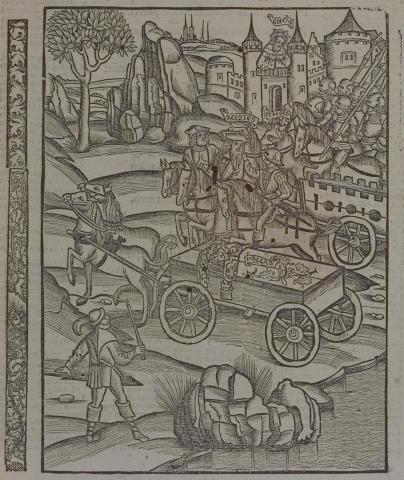Annotations
In the center of the image is the bier of Pallas. Here it is constructed out of wood rather than Vergil's wicker, arbutus (strawberry tree) shoots, and oak branches (64-6), though Brant alludes to these elements by having oak leaves and sprigs of arbutus. On top of Pallas's bier, to the left of the leaves is draped one of two elaborately embroidered robes which Dido gave to Aeneas, and which Aeneas now uses as a shroud for Pallas's coffin (72-7). The bier is pulled by a pair of horses. In the upper right, Aethon, Pallas's war horse (89-90) is part of the procession that accompanies Pallas back to Pallanteum, along with a wagon of spoils and an array of Tuscan, Teucrian, and Arcadian cavalry and infantry holding their spears upside down in mourning (92-4). Acoetes, who is labeled here and in Brant's version of the text as Acestes, rides in front of the cavalry, helped along by two men (85-7). The war prisoners mentioned by Vergil, sent by Aeneas as sacrifices, (81-4) are not shown, possibly for moral reasons. Aeneas watches from inside the city as the train leaves for Pallanteum (94-99).
Woodcut illustration from the “Strasbourg Vergil,” edited by Sebastian Brant: Publii Virgilii Maronis Opera cum quinque vulgatis commentariis expolitissimisque figuris atque imaginibus nuper per Sebastianum Brant superadditis (Strasbourg: Johannis Grieninger, 1502), fol. 371r, executed by an anonymous engraver under the direction of Brant.


Sebastian Brant (1458-1521) was a humanist scholar of many competencies. Trained in classics and law at the University of Basel, Brant later lectured in jurisprudence there and practiced law in his native city of Strasbourg. While his satirical poem Das Narrenschiff won him considerable standing as a writer, his role in the transmission of Virgil to the Renaissance was at least as important. In 1502 he and Strasbourg printer Johannes Grüninger produced a major edition of Virgil’s works, along with Donatus’ Life and the commentaries of Servius, Landino, and Calderini, with more than two hundred woodcut illustrations. (Annabel Patterson)